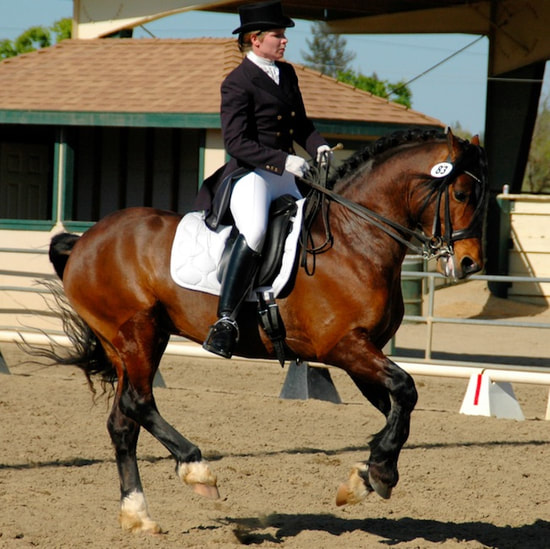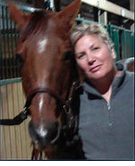Executing the Perfect Half-Halt Needn't be a Mystery.
Here's What You Need to Know.
Both trainer and student felt exasperated. "Half halt! Half halt!", the trainer repeatedly called, yet the student didn't comply. "I AM half halting", thought the student, in frustration. Finally, the student came to a complete stop in front of the trainer and asked, "What exactly do you mean by half halt--because I feel like I've done a million of them by now."
|
A half-halt is the secret to elevated gaits, brilliance, and expressiveness in your dressage movements. It is the way you prepare your horse for transitions, and the way you control his speed and impulsion. Yet most riders have no idea how to properly execute one.
|
The essence of the half halt is sending your horse’s energy back to his haunches. This not only affects his speed, it puts him in a more balanced position to jump. Green horses typically carry about 75% of their weight on the forehand, giving them a “downhill” feel when being ridden. The job of a quality trainer is to teach the horse a better way of going under saddle, which moves
|
some of that weight toward the haunches. When executed properly, the horse becomes more balanced back-to-front, and feels more “horizontal” than downhill. In the highest levels of collection, the horse feels very “up hill”. The more “up hill” the horse, the more he can drive from behind, a characteristic dressage riders call impulsion. And the more in control the rider is.
The half-halt is not just important for dressage. It is absolutely crucial for jumping. The half-halt is how you control your horse as he jumps a course. Without this skill, your horse will progressively increase speed with each jump until you are practically flying out of control toward the end of the course. You can find specific instructions for the How To Control Your Horse's Speed here.
First, let's get a good, clear image in your mind of what a properly executed half halt looks like. It's difficult to learn a movement when you have no clear idea what you're aiming for.
In this video, a rider demonstrates how to do a perfect half halt. The slow motion segments make it crystal clear what she is doing and how it dramatically affects the horse's carriage and tempo.
The half-halt is not just important for dressage. It is absolutely crucial for jumping. The half-halt is how you control your horse as he jumps a course. Without this skill, your horse will progressively increase speed with each jump until you are practically flying out of control toward the end of the course. You can find specific instructions for the How To Control Your Horse's Speed here.
First, let's get a good, clear image in your mind of what a properly executed half halt looks like. It's difficult to learn a movement when you have no clear idea what you're aiming for.
In this video, a rider demonstrates how to do a perfect half halt. The slow motion segments make it crystal clear what she is doing and how it dramatically affects the horse's carriage and tempo.
HOW TO EXECUTE THE PERFECT HALF-HALT
The half-halt comes from your core muscles, not from your hands. It isn’t a matter of squeezing the reins half as hard as you would for a full halt. Instead, it comes from your powerhouse of core muscles. When executing a half-halt, keep your shoulders low, but stretch your torso so that it feels longer. Tighten your abs and lower back by rotating your pelvis under you so that your buttocks and lower back flatten and your pubic bone moves up in the direction of your navel. If you take Pilates, yoga, or martial arts, this move will be familiar to you. It provides a core of power and stability to your stance. At the same time that you engage your abs and lower back, squeeze (not pull) your reins by closing your fingers, allowing your little finger to come closer to the underside of your wrist. This has the effect of shifting your weight back towards the horse’s haunches and closing an invisible barrier in front of your horse’s nose. The effect on your horse will be to slow him down, and to rebalance him as well by shifting more of his weight toward his haunches. This also will flex his jaw and poll, raise his back, and put his hind legs more underneath him so that he can drive from behind.
To practice this, be sure your stirrups are low enough so that your hip angle is sufficiently open to allow your pelvis freedom to move. Otherwise, you won't be able to execute the half-halt properly. Put your horse into trot and post. Allow your hips to swing forward as you rise from the saddle. When your horse is trotting forward with a lot of energy, abruptly tighten your core muscles, shift your weight slightly back from your legs, hips, back, and shoulders, and squeeze your hands as you rise up out of the saddle. Think about and feel what is happening behind you so that your focus is on your own weight moving back in the saddle. Your horse should respond to this sudden rebalancing of your weight by slowing his pace and elevating his trot. If he doesn’t respond the first time, be patient. He may not be used to paying much attention to what’s happening there on his back, particularly if he is used to you controlling him by pulling and pulling on the reins.
Once your horse reliably responds to this rising version of the half halt, you’re ready to try the actual half-halt at trot and canter. Establish an energetic trot, then “stretch up tall” by lengthening your torso (your shoulders remain low), tuck your bottom under, tighten your abs and lower back, shift your weight back slightly from your legs, hips, and shoulders, and squeeze your fingers to tighten your fists. Again, think and feel that your own weight is shifting toward your back and your horse’s back. You should feel your horse respond to this shift in your weight. His pace should slow, his back should rise under you, his poll should flex, and his weight should shift back in the direction of his haunches. He will still feel very “stretchy” and powerful, but you will feel more in control of him.
Continue to practice this at trot until your horse reliably and immediately responds to your half halt. Then do the same thing at canter.
Using the half halt this way will improve your control of your horse, build your horse’s topline, and improve his gaits so that they are less “rushy” and more elevated. Your dressage scores should improve as a result, and your horse should struggle less as you ride more advanced moves and figures.
Remember to be patient if your horse puts up a fight by trying to go back to his old ways. Habits are hard to change. But patience and persistence will teach him that YOU are in control of his tempo, and that he benefits from walking, trotting, and cantering this way.
Find more great articles on dressage here.
Find more great articles on jumping here.
Happy riding!
Copyright Denise Cummins, PhD March 2016; Updated Jan 22, 2020
The Thinking Equestrian
Continue to practice this at trot until your horse reliably and immediately responds to your half halt. Then do the same thing at canter.
Using the half halt this way will improve your control of your horse, build your horse’s topline, and improve his gaits so that they are less “rushy” and more elevated. Your dressage scores should improve as a result, and your horse should struggle less as you ride more advanced moves and figures.
Remember to be patient if your horse puts up a fight by trying to go back to his old ways. Habits are hard to change. But patience and persistence will teach him that YOU are in control of his tempo, and that he benefits from walking, trotting, and cantering this way.
Find more great articles on dressage here.
Find more great articles on jumping here.
Happy riding!
Copyright Denise Cummins, PhD March 2016; Updated Jan 22, 2020
The Thinking Equestrian
|
Denise Cummins has over 30 years experience as an equestrian and horse business owner. In The Thinking Equestrian, she shares valuable tips on caring for and training horses, giving riding instruction, and running a successful horse business.
Opening Photo Credit: By Nikki [CC BY-SA 2.0 (http://creativecommons.org/licenses/by-sa/2.0)], via Wikimedia Commons |
|
|
|
|
|





